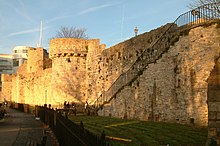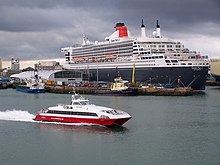Visit Southampton Place – things to do & explore
![]() Visit Southampton places on a day-trip, weekend away or holiday – and Walkfo becomes your personal digital tour guide to Southampton things to do.
Visit Southampton places on a day-trip, weekend away or holiday – and Walkfo becomes your personal digital tour guide to Southampton things to do.
Visiting Southampton Overview
Southampton is a port city in the ceremonial county of Hampshire on the south coast of England . It is located 70 miles (110 km) south-west of London and 15 miles (24 km) west of Portsmouth . A major port, and close to the New Forest, it lies at the northernmost point of Southampton Water . The city was heavily bombed during the Second World War during what was known as the Southampton Blitz .
When you visit Southampton, Southampton history becomes available at the places you travel to by foot, bike, bus or car with a mobile phone & headphones.
Southampton places overview by Walkfo
Visit to Southampton stats
With 148 tourism audio plaques & places for you to explore in Southampton, Walkfo is the world’s largest heritage & history digital plaque provider in the world. Our AI continually learns & refines content about the best Southampton places to visit from online information authorities like Wikipedia for current & history, and converts it into an audio experience.
Southampton history
Pre-Norman
Clausentum was an important trading port and defensive outpost of Winchester . It was defended by a wall and two ditches and is thought to have contained a bath house . The Anglo-Saxons formed a new, larger, settlement across the Itchen centred on St Mary’s area of the city .
11th–13th century
Southampton Castle was built in the 12th century and surviving remains of 12th-century merchants’ houses such as King John’s House and Canute’s Palace are evidence of the wealth that existed in the town at this time . Following the Norman Conquest in 1066, Southampton became the major port of transit between the then capital of England, Winchester, and Normandy .
14th century

Between 1327 and 1330, the King and Council received a petition from the people of Southampton . The community of Southampton claimed that Robert Batail of Winchelsea and other men of the Cinque Ports came to Southampton under the pretence that they were a part of Thomas of Lancaster’s rebellion against Edward II . The petition states that, the supposed rebels in the Despenser War ‘came to Southampton harbour, and burnt their ships, and their goods, chattels and merchandise which was in them, and took some of the ships with them’
15th century
The city walls include God’s House Tower, the first purpose-built artillery fortification in England . The walls were completed in the 15th century, but later development of several new fortifications along Southampton Water and the Solent meant that Southampton was no longer dependent upon its fortifications . During the Middle Ages, shipbuilding had become an important industry for the town .
16th and 17th centuries
The port was the point of departure for the Pilgrim Fathers aboard Mayflower in 1620 . In 1642, a Parliamentary garrison moved into Southampton during the English Civil War . The Royalists advanced as far as Redbridge in 1644 but were prevented from taking the town .
18th century
Southampton became a spa town in 1740 . It had become a popular site for sea bathing by the 1760s, despite the lack of a good quality beach . Innovative buildings specifically for this purpose were built at West Quay .
19th century
The town experienced major expansion during the Victorian era . The Southampton Docks company had been formed in 1835 . The railway link to London was fully opened in May 1840 . Southampton became known as The Gateway to the Empire .
20th century

In 1912, the RMS Titanic sailed from Southampton, four in five of the crew on board the vessel were Sotonians . Southampton was designated No. 1 Military Embarkation port during the Great War and became a major centre for treating the returning wounded and POWs . It was also central to the preparations for the Invasion of Europe in 1944 .
21st century
In 2016 the south section of West Quay was opened to the public . The public plaza has been used for several annual events, such as an ice skating rink and a public broadcast of Wimbledon tennis .
Southampton geography / climate
The geography of Southampton is influenced by the sea and rivers. The city lies at the northern tip of the Southampton Water, a deep water estuary formed at the end of the last Ice Age. The River Test runs along the western edge of the city, while the Itchen splits Southampton in two—east and west. Town Quay is the original public quay, and dates from the 13th century.
Areas and suburbs

Southampton is divided into council wards, suburbs, constituencies, ecclesiastical parishes, and other less formal areas . It has a number of parks and green spaces, the largest being the 148-hectare Southampton Common . The city is ranked 96th most deprived out of all 354 Local Authorities in England .
Climate
As with the rest of the UK, Southampton experiences an oceanic climate (Köppen: Cfb) Its southerly, low-lying and sheltered location ensures it is among the warmer, sunnier cities in the UK . It has held the record for the highest UK temperature in June at 35.6 °C (96.1 °F)
Energy

The centre of Southampton is located above a large hot water aquifer that provides geothermal power to some of the city’s buildings . This energy is processed at a plant in the West Quay region in Southampton city centre . The plant provides private electricity for the Port of Southampton and hot water to the Southampton District Energy Scheme used by many buildings .
When you visit Southampton
You can visit Southampton places and use Walkfo Southampton to discover the history & things to do in Southampton whilst walking with our free digital tour app. Walkfo Southampton has 148 places on our Southampton map with history, culture & travel facts that you explore the same way you would at a museum or art gallery with information audio headset. With Walkfo, you can travel by foot, bike or bus throughout Southampton, being in the moment, without digital distraction or limits to a specific walking route – you choose where you want to go, when you want to go and Walkfo Southampton will keep up.![]()
–
With millions of places including tourist walks, Southampton travel destinations, National Trust locations converted to audio experiences, our Southampton places AI guide will help you get the best from your visit to Southampton & the surrounding areas. The Southampton places app for iPhone & Android delivers hidden history, interesting culture and amazing facts in interactive audio stories in response to where you walk at National Heritage sites, tourist attractions, historic locations or city streets, with no predefined walk map requirements.
“The Walkfo AI has curated content for millions of locations across the UK, with 148 audio facts unique to Southampton places forming an interactive Southampton map for you to explore.”
Walkfo’s Visit Southampton Places Map
148 tourist, history, culture & geography spots
Southampton historic spot | Southampton tourist destination | Southampton plaque | Southampton geographic feature |
| Walkfo Southampton tourism map key: places to see & visit like National Trust sites, Blue Plaques, English Heritage locations & top tourist destinations in Southampton | |||
Best Southampton places to visit
Southampton has many places to explore by foot, bike or bus. Below are a selection of the varied Southampton’s destinations you can visit with additional content available at the Walkfo Southampton’s information audio spots:
 | R J Mitchell Wind Tunnel The R. J. Mitchell Wind Tunnel is part of the Faculty of Engineering and the Environment at the University of Southampton. It is the largest wind tunnel in University ownership in the UK. |
 | St. Alban’s Church, Southampton St. Alban’s Church, Swaythling, Southampton, stands on Tulip Road, just off the main Burgess Road. The church, and its associated hall, is a Grade II listed building. |
 | Clausentum Clausentum was a small town in the Roman province of Britannia. The site is believed to be located in Bitterne Manor, now a suburb of Southampton. |
 | Old Farmhouse, Southampton The Old Farmhouse was originally a farmhouse and dates back to at least 1560. It was rebuilt in 1611 and converted to its current usage in 1843. It is situated adjacent to the Mount Pleasant level crossing on the South West Main Line. |
 | St. Michael and All Angels Church, Bassett St. Michael and All Angels Church, in Bassett, Southampton, is an Anglican parish church which dates from the late 19th century. |
 | Hollybrook Cemetery Hollybrook Cemetery is one of the main cemeteries in Southampton. It contains around 53,000 graves as of August 2012 and still open to new burials as of March 2016. |
 | Southampton Cenotaph The Southampton Cenotaph was the first of dozens by Lutyens to be built in permanent form. It is a tapering, multi-tiered pylon which culminates in a sarcophagus which features a recumbent figure of a soldier. The names of the dead are inscribed on three sides. |
 | Watts Park Watts Park is named in honour of Isaac Watts, a Congregationalist minister and hymn writer. It was built between 1854 and 1866 and was designated Grade II* in 1995. |
 | Southampton Tunnel Southampton Tunnel is a 528-yard railway tunnel that runs close to the Civic Centre in the centre of the city of Southampton. It was constructed by the Southampton and Dorchester Railway to join the London and Southampton Railway. The tunnel suffered a collapse during construction, and subsequent movement of the structure delayed its opening until two months after that of the rest of the line. |
 | Above Bar Church, Southampton Above Bar Church is affiliated to the Fellowship of Independent Evangelical Churches. The building is on the corner of Above Bar Street and Ogle Road in Southampton City Centre. |
Visit Southampton plaques
![]() 18
18
plaques
here Southampton has 18 physical plaques within tourist plaque schemes for you to explore via Walkfo Southampton plaques when visiting. Plaque schemes such as National Heritage’s “Blue Plaques” provide visual geo-markers to highlight points-of-interest at the places where they happened. Where a plaque is available, Walkfo AI has done research to provide additional, deeper content when you visit Southampton using the app. Experience hidden history & stories at each location as the Walkfo local tourist guide app uses trigger audio close to each Southampton plaque. Explore Southampton Plaques & History has a complete list of Hartlepool’s plaques & Hartlepool history plaque map.

